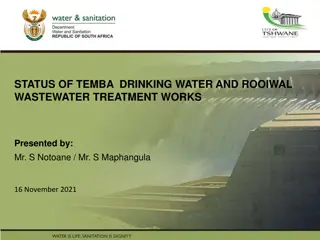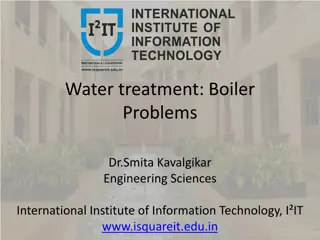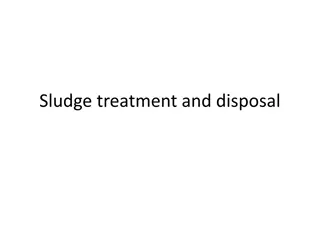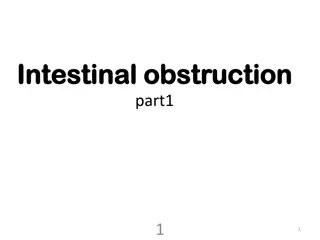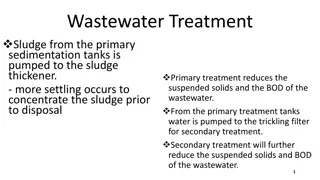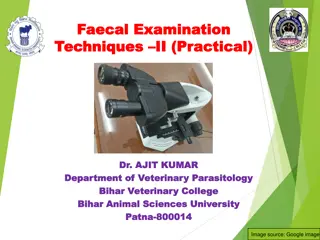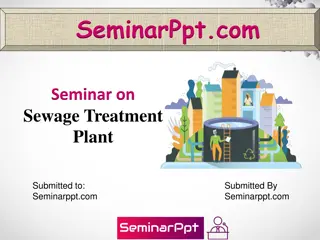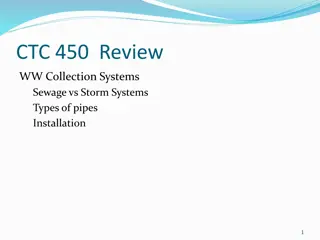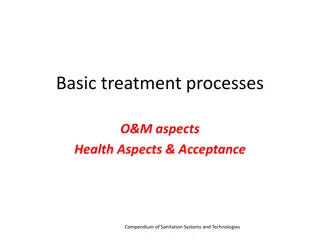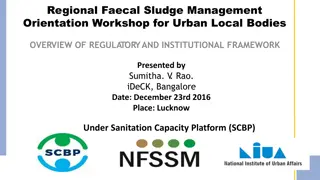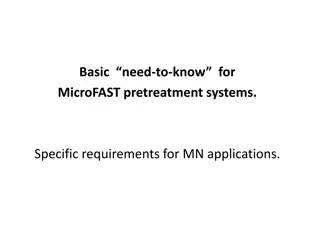Advanced Treatment Processes for Faecal Sludge Management
Treatment processes for faecal sludge management involve various stages including preliminary treatment, primary treatment, secondary treatment, and tertiary treatment. Each stage employs mechanical, biological, and chemical processes to separate, decompose, and remove contaminants from the sludge, ensuring effective treatment and reduction of harmful pollutants. Key steps include receiving bay and balancing tank operations, settler for solid/liquid separation, anaerobic baffled reactor for biological treatment, and vertical flow constructed wetland for tertiary treatment. These processes aim to achieve significant removal of organic matter, pathogens, and nitrogen from the sludge, ultimately enhancing treatment performance and ensuring environmental safety.
- Faecal Sludge Management
- Treatment Processes
- Advanced Treatment
- Wastewater Treatment
- Environmental Engineering
Download Presentation

Please find below an Image/Link to download the presentation.
The content on the website is provided AS IS for your information and personal use only. It may not be sold, licensed, or shared on other websites without obtaining consent from the author. Download presentation by click this link. If you encounter any issues during the download, it is possible that the publisher has removed the file from their server.
E N D
Presentation Transcript
TREATMENT PRINCIPLES OF A DTF 1 Receiving Bay / Balancing Tank (Preliminary treatment) Entry point of the faecal sludge Mechanical treatment Receiving bay: the inflow is screened and the coarse material is removed Balancing tank: the faecal sludge is stored and the outflow is controlled via an outlet valve to provide constant flow towards the next modules 2 Settler (Primary treatment) Separation of solid/liquid (removal of easily settleable solids) Mechanical treatment: sedimentation/flotation retains contaminants Biological treatment: anaerobic microorganisms present in the settled sludge partially decomposes the organic pollutant. Digestion process ensures that the accumulated sludge is reduced and stabilized
3 Anaerobic Baffled Reactor (Secondary treatment) Biological treatment: from top to bottom (in the down pipes): the effluent is forced through the activated sludge where anaerobic bacterial mass degrades the suspended and dissolved solids From bottom to top (in the chambers): sludge particles settle against the up-stream of the effluent, providing intense contact between resident sludge and effluent (increased contact time with active biomass) Anaerobic digestion: large variety of microorganisms (bacteria and methanogens) that convert complex organic compound into simple molecules like methane and carbon dioxide. The process can be roughly divided into 4 stages: hydrolysis, acidogenesis, acetogenesis and methanogenesis. The overall simplified reaction is shown in the following equation: Organic matter CH4 + CO2 + H2 + NH2 Methane Carbon dioxide + H2S Hydrogen sulfide Dihydrogen Amidogen Treatment performance ranges from 65 to 90% BOD removal
4 Vertical Flow Constructed Wetland (Tertiary treatment) O2 O2 Oxygen enters the filter media via: The resting time in between the discontinuous dosage feeding The macrophytes which transfer oxygen from the atmospheric air through the rhizomes and roots Polishing step (removal of remaining solids) Mechanical filtering: the suspended solids are removed through physical filtration and sedimentation Chemical adsorption: Phosphorus co-precipitates with iron, aluminium and calcium compounds located in the root-bed medium Biological conversion: aerobic and anaerobic microorganisms facilitates the decomposition of organic matter and enable nitrification and subsequent denitrification to release nitrogen as gas to the atmosphere Removal of harmful bacteria and viruses through natural predation occurring in the biofilm growing on the filter media Treatment performance ranges from 90 to 95% BOD Reduction of infective organisms over 95% Nitrogen removal limited to 30 to 40%
Nitrification Biological conversion of ammonium to Nitrate. Nitrifiers (aerobes bacteria) work strictly under aerobic conditions (DO > 1.0 mg/L) Denitrification Biological reduction of Nitrate to Nitrogen gas. Heterotrophic (facultative) bacteria get their oxygen by taking dissolved oxygen out of the water or by taking it off nitrate molecules. Denitrification occurs when oxygen levels are depleted and nitrate becomes the primary oxygen source for microorganisms. NH4 N I T R I F I C A T I O N N I T R I F I C A T I O N (aerobic conditions) (aerobic conditions) Ammonia Nitrosomonas NO2- Bacillius Pseudomonas Clostridium Nitrite Escaped into the atmosphere Nitrobacter NO2- NO3- N2O NO N2 Nitrous Oxide Nitrate Nitrite Nitric Oxide Nitrogen D E N I T R I F I C A T I O N D E N I T R I F I C A T I O N (anoxic conditions) (anoxic conditions)
5 Sludge Drying Beds (Sludge treatment) The drying process is based on two principles: Percolation of the leachate through sand and gravel (50 to 80% of the total volume) Evaporation of the bound water fraction of the sludge (20 to 50% of the total volume) Sludge partly stabilised Dehydration kills pathogens through UV radiation, heat and absence of water Leachate must be treated further Co-composting process 6 Composting area (Sludge treatment) 70 Temperature in degrees C 60 50 Remove the remaining pathogens of the sludge during the peak of temperature (65 C) Add a fertilizing value to the compost (Nitrogen, Phosphorus and Carbon) 40 30 20 10 Thermophilic phase Mesophilic phase 0 In agriculture, a thin layer of compost applied to crops increases microbial activity, helps the soil to retain water, improves the soil s structures and provide plants with essential nutrients. 0 2 4 6 8 10 12 Time in weeks








